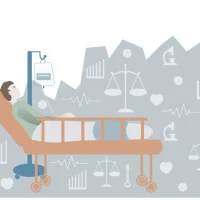HealthManagement, Volume 18 - Issue 1, 2018
The race is on to implement technology effectively for improved liaising and better health outcomes.
Health technology can change healthcare but only with implementation of basics such as collaboration, communication and easy exchange, combined with transformation of some traditional workflows.
AirBNB, TripAdvisor, Uber, OpenTable, WhatsApp and many others have appeared in a disrupting manner and have changed the market and the approach to it. They each have two very important things in common: they are global concepts applied locally and are led by users who are the main beneficiaries of these platforms. The user is not only in the centre but is, in fact, the centre. It is the user who directs, decides and values.
Not only have processes changed but each of the above has also helped improve competition. I remember how difficult it was to get an airport taxi five years ago in New York. but on a recent trip there, I could see how the official taxis had new regulations such as the obligation to take a passenger and prohibition of talking on the phone while driving. I think this is thanks to Uber.
Health Information Systems: the basis that should exist
And what is happening in healthcare? The sector continues to be mysteriously immobile. The system still controls processes and information with paternalistic excuses – but, in spite of this, the trend that supports patient ownership of medical history is already well underway.
Another obstacle is that there is no solid foundation on which to build. Information systems and electronic medical records are moderately implemented within and between healthcare facilities but it is not a robust, solid and interconnected basis on which new models can be built. In other sectors, such as banking, travel and hospitality, there are more solid computer systems that allow other systems to be built upon them. innovation and competition is promoted.
In healthcare we usually cannot consider making an appointment reservation system with the medical centres of a city (private, insurer or public) without starting from the base. Each entity manages it in a controlled way through its website. Nor can we easily access a specialist. It is the system that will direct us to the specialist that is considered most appropriate.
New online processes, activator of Health 2.0
Yes it is true that there have been advances. There are platforms and portals that allow the search of, appointment with and assessment from a doctor. There are clear processes for a second opinion. Patients who want another doctor to review what their assigned doctor has told them can now do so online. I had the opportunity to work four years in a global company, BestDoctors, that offered second opinion medical services. The experience and the learning were formidable. We designed a powerful system that allowed the collection of clinical information, evaluation and analysis to select the expert in the field and all the exchange of information, reports and images so that the specialist could evaluate and give their opinion. This saw exchange of information and services amongst patients and doctors in the UK, Holland and New Zealand, the United states and other countries, making a global and accessible system. New web platforms have appeared (TopDoctors, Doximity, Grandrounds) where the whole process is online and managed by the user. The patient is central.
Communication, collaboration and coordination
After 20 years working passionately in eHealth projects, I have been able to participate in projects of all kinds: digitalisation of electronic health records (EHRs) in hospitals and health services, corporate health history projects and citizen clinical protocols, global platforms of collaboration and exchange of clinical cases and global initiatives of second medical opinion, etc. In the end, there has always been a common element identified as a fundamental problem: lack of communication and coordination.
Users have always demanded an adequate communication system that allows multidisciplinary care teams to communicate easily and efficiently.
The American Institute of Medicine (IOM) in its Improving Diagnosis in Healthcare report published in the autumn of 2015 concluded that improving the diagnostic process required greater levels of collaboration and improvement of communication. The IOM report showed that to address problems such as diagnostic and treatment errors it is also necessary to use new approaches to the problem and tools that are different from the traditional ones. The report concluded that the diagnostic process is a collaborative process and, in the immediate future, will require collaboration tools that integrate and promote the communication of all the people who contribute to the process. This would mean involving family members and the patient, as well as caregivers, doctors, nurses and social agents.
Nobody disputes using Information and Communications technology (ICT) to improve notification systems. It is no longer about boosting the electronic medical record, but to take a step further: promote exchange, collaboration and communication.
The health system boasts of focusing on the patient as the main axis, but the patient goes beyond the health system and may not need a system as protectionist or paternalistic. The patient moves, travels, changes the system, city or country, seeks a second opinion or the opinion of an expert or friend and has an environment around him that supports him in his care (caregivers at home, residences, rehabilitation centers, etc.) or in their day-to-day life (exercise, food, etc.). There are new services, like Idonia.com, that provide a free-to-use exchange platform where hospitals can deliver the medical images and tests to patients using the internet and avoiding the painful CD/DVD burning and delivering process. Patients can also manage and
share their medical images and information in a secure environment.
Take into account the survey among 955 health professionals conducted by Harris Poll for Perfect- Serve4 in U.S. (Perfect Serve 2015) where they represent a large majority of actors in the ecosystem: specialised doctors, primary care physicians, nurses, case managers and administrators.
The vast majority (98 percent) considered it necessary to improve communication and assistance to reduce readmissions and improve population management.
Some interestingresultsincluded:
Communication
- 69 percent of professionals considered that patient care was delayed while waiting for important information about the patient
- More than half of the professionals admitted that they did not always know the member of the healthcare team to contact in a given situation
- 71 percent of doctors said they had lost time trying to communicate with the healthcare team
- Only 25 percent considered that they could contact colleagues to collaborate or consult in an effective way.
Technology
- Telephone (83 percent) and patient portals (74 percent) were the two most commonly used forms of communication
- Among the clinicians, when it was necessary to contact a specialist doctor about a complex case, the EHR was used only 12 percent of the time
- Most nurses and managers did not believe that the EHR was adequate for effective communication with doctors
Lack of time, difficulty in finding other doctors, lack of personal relationship with other doctors, lack of information feedback, discrepancy in medical prescription and lack of clarity in pending tests and home care are further problems identified among professionals. Studies identify different ways in which the coordination of the healthcare team could be improved. Many times those involved were not aware of the problems encountered by their colleagues - for example, that the primary care physician or care team was admitted to emergency. There were also coordination problems in the follow-up of a patient at discharge, pending tests or home care.
It seems clear, therefore that improving the coordination and communication of the care team could prevent readmissions and loss of tests with the resulting unnecessary repetition.
Communication and clinical collaboration are key to improving the diagnostic process as well as for the efficient monitoring of a patient and are applicable and necessary in different clinical scenarios such as home care, healthcare partner, primary/specialised care coordination, non-physical care and multicentre collaboration.
Big data, Artificial Intelligence (AI) and Chatbot are trending topics and, although it may not be possible to obtain the same value as applying them to other more mature sectors technologically, they can help the digital transformation in healthcare.
Artificial Intelligence
In imaging analysis, for example, there are tools of artificial intelligence that can be trained in a specific pathology to support a diagnostic process. Google is promoting a project focused on diabetic retinopathy in the UK.
An innovative and totally disruptive initiative in which I have been able to collaborate recently is particularly relevant. It is about combining AI with automated communication mechanisms (Chatbots) to improve the monitoring and communication of chronic patients. For this project there has been an interesting alliance between two entities. On the one hand a home care company in the Balearic Islands for the personalised monitoring of chronic patients at home has managed to retain patients through constant communication. On the other hand, a technology company, specialised in eHealth, medical imaging, artificial intelligence and transactional chatbots applied to different health processes and scenarios has also been active.
Through this alliance, they have managed to create the first virtual brain to monitor and control chronic patients at home in the form of a virtual assistant who controls and monitors patients by communicating with them in a simple and direct way. The virtual assistant reminds patient to take medication and records data periodically through an automatic conversational system based on AI concepts. A control system (the brain) helps to prioritise actions, control and classify patients and automates certain tasks that are repetitive. It also distributes tasks to doctors, nurses, caregivers, rehabilitators and, if applicable, family members. This allows the support team to focus on patients who require immediate action as identified by the virtual assistant and the intelligence system.
Technology, in this case, is a differential change. The main effort has been to create a solution as powerful in its action as it is simple in its presentation. The focus has been on giving value to the process. Without the need for a complex and confusing app for the user, a virtual assistant controls everything that happens, coordinates and establishes communication links. Anybody from the healthcare team can be in constant contact and avoid traditional misunderstandings and miscommunication issues.
Promoting communication and collaboration in parallel to improving information systems is essential. Integrating all the care, clinical and social teams that interact with the patient inside and outside the system (residences, hospices, rehabilitation centres, caregivers, nurses, etc.) is a basic step for ward for digital transformation.
With different experiences and projects I believe that solving a basic problem such as lack of communication would be a first step. It is a fundamental aspect in the change that has to occur in the healthcare sector. Change is not only digital. I hope that the change occurs before we are forced to make it.
Key Points
- Technological disruption has improved competition in a range of sectors while healthcare is lagging
- In healthcare there is not a solid and interconnected basis on which robust communication models can be built
- There are some encouraging examples in healthcare where the patient is central
- ICT can promote exchange, collaboration and communication as well as boosting EHR use
- Studies show better coordination amongst healthcare personnel is needed for improved overall efficiency
- It is essential to promote communication and collaboration in parallel to improving information systems in healthcare
References:
Institute of Medicine (2015) Improving Diagnosis in Health Care [Accessed 4 January 2018]. Available at: http://www.nationalacademies.org/hmd/~/ media/Files/Report%20Files/2015/Improving-Diagnosis/DiagnosticError_ ReportBrief.pdf
Perfect Serve (2015) Efforts to improve population health hampered by lack of communication among healthcare professionals [Accessed 2 January 2018]. Available at: http://www.per fectser ve.com/press-releases/effor ts-to-improve- population-health-hampered-by-lack-of-communication-among-healthcare- professionals/




